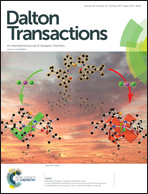Zn(ii) and Cu(ii) complexes containing bioactive O,O-chelated ligands: homoleptic and heteroleptic metal-based biomolecules†
Abstract
Historically, many useful drugs have been developed from natural sources and their mechanisms of action deeply investigated for therapeutic applications. Recently, the interaction between pharmacologically active biomolecules and transition metal ions has opened the way to the construction of new drugs, where the unique properties of metal complexes are combined with the specific mechanisms of action of the coordinated bioligands of natural extraction. In this context, this perspective summarizes some recent research studies devoted to the development of new metal-based drugs containing Zn(II) or Cu(II) metal ions. Both metals have a strong tendency to form highly stable complexes with N,N- and O,O-donor ligands bound through chelation, giving rise, particularly when the bound organic molecules are drug candidates of natural extraction, to drug delivery systems, new biologically active complexes and potential diagnostic agents due to their intrinsic spectroscopic properties.


 Please wait while we load your content...
Please wait while we load your content...